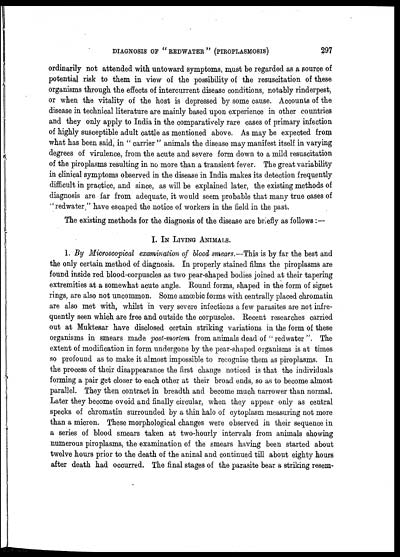Medicine - Veterinary > Veterinary colleges and laboratories > Indian journal of veterinary science and animal husbandry > Volume 1, 1931 > Part IV (December 1931) > Diagnosis of "redwater" (piroplasmosis) in Indian cattle
(344) Page 297
Download files
Individual page:
Thumbnail gallery: Grid view | List view

DIAGNOSIS OF " REDWATER " (PIROPLASMOSIS) 297
ordinarily not attended with untoward symptoms, must be regarded as a source of
potential risk to them in view of the possibility of the resuscitation of these
organisms through the effects of intercurrent disease conditions, notably rinderpest,
or when the vitality of the host is depressed by some cause. Accounts of the
disease in technical literature are mainly based upon experience in other countries
and they only apply to India in the comparatively rare cases of primary infection
of highly susceptible adult cattle as mentioned above. As may be expected from
what has been said, in " carrier " animals the disease may manifest itself in varying
degrees of virulence, from the acute and severe form down to a mild resuscitation
of the piroplasms resulting in no more than a transient fever. The great variability
in clinical symptoms observed in the disease in India makes its detection frequently
difficult in practice, and since, as will be explained later, the existing methods of
diagnosis are far from adequate, it would seem probable that many true cases of
"redwater " have escaped the notice of workers in the field in the past.
The existing methods for the diagnosis of the disease are briefly as follows :—
I. IN LIVING ANIMALS.
1. By Microscopical examination of blood smears.—This is by far the best and
the only certain method of diagnosis. In properly stained films the piroplasms are
found inside red blood-corpuscles as two pear-shaped bodies joined at their tapering
extremities at a somewhat acute angle. Round forms, shaped in the form of signet
rings, are also not uncommon. Some amœbic forms with centrally placed chromatin
are also met with, whilst in very severe infections a few parasites are not infre-
quently seen which are free and outside the corpuscles. Recent researches carried
out at Muktesar have disclosed certain striking variations in the form of these
organisms in smears made post-mortem from animals dead of "redwater ". The
extent of modification in form undergone by the pear-shaped organisms is at times
so profound as to make it almost impossible to recognise them as piroplasms. In
the process of their disappearance the first change noticed is that the individuals
forming a pair get closer to each other at their broad ends, so as to become almost
parallel. They then contract in breadth and become much narrower than normal.
Later they become ovoid and finally circular, when they appear only as central
specks of chromatin surrounded by a thin halo of cytoplasm measuring not more
than a micron. These morphological changes were observed in their sequence in
a series of blood smears taken at two-hourly intervals from animals showing
numerous piroplasms, the examination of the smears having been started about
twelve hours prior to the death of the aninal and continued till about eighty hours
after death had occurred. The final stages of the parasite bear a striking resem-
Set display mode to: Large image | Zoom image | Transcription
Images and transcriptions on this page, including medium image downloads, may be used under the Creative Commons Attribution 4.0 International Licence unless otherwise stated. ![]()
| Permanent URL | https://digital.nls.uk/75226827 |
|---|
| Description | Covers articles from 1931. |
|---|




